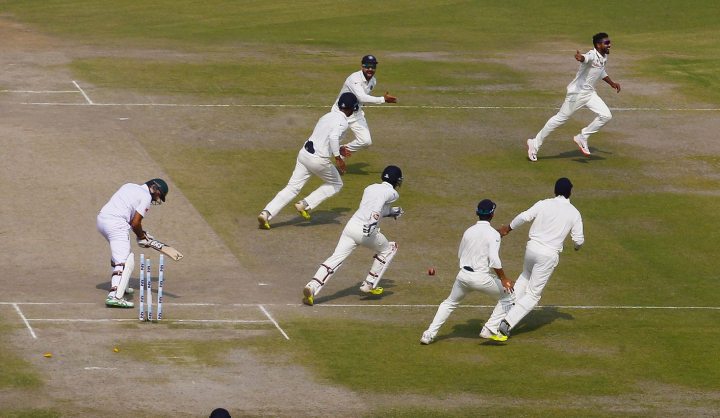Sport
India vs SA, first Test: No use crying over a spinning pitch

The pitch was one of the main talking points during the first Test between India and South Africa in Mohali. But it was hardly a rank turner, and it was lack of application that let both sides down. It’s called Test cricket for a reason: you are being tested and South Africa’s batsmen have failed the test. By ANTOINETTE MULLER.
Pitches have become a sort of 12th man in cricket. There are murmurs of home teams pulling groundsmen’s strings to get them to curate surfaces that benefit the hosts. For some observers, this is unfair meddling, for others, it’s simply the most basic form of home ground advantage.
After 12 wickets fell on day one of the first Test between South Africa and India, and Dean Elgar said the track was “playing like a day-four wicket”, pockets of people were up in arms about the turner Mohali had dished up. Traditionally, the wicket here has been kind to the game all-round, but spinners have always been the most successful.
The turn on day one, which was exploited by both India and South Africa, caused much consternation, but it is largely unnecessary. Would there be so much outrage if, for example, South Africa prepared a blitz track in the Highveld, and the opposition was rolled over in a day? Probably not.
Crying over assistance for spinners, while you would probably praise a fast track, reeks of a Western superiority complex. It’s also double standards, of the extreme, to constantly be crying over how “batsmen are dominating the game”, but as soon as spinners start to dominate, on a surface that suits them, there is outrage. TV people will raise a cautious eyebrow as they need eyeballs on the box for five days, but this is not about them.
The whole point behind playing at home – and the reason why South Africa’s away record is so impressive – is that it takes the opposition out of their comfort zone. India are comfortable with spin, so why shouldn’t they use that to their advantage? In the past, South Africa have been successful in India, because they have largely taken the surface out of the equation. They did not quite manage that in Mohali, but it was not their bowlers that let them down.
Despite what the outrage gallery might have you believe, the reason South Africa lost had nothing to do with the pitch. While there was some turn on offer, it hardly ever turned square, and lack of application was a far bigger concern than a wicket that played a few tricks.
It’s called Test cricket for a reason: you are being tested and South Africa’s batsmen have failed the test.
In the first innings, only three players (Elgar, Hashim Amla and AB De Villiers) managed more than half-an-hour at the crease. The three of them spent between just under two hours to nearly three in the middle, but the support was non-existent. It was much the same in the second innings, with just two players this time – Elgar and Stiaan van Zyl – managing more than 60 minutes out in the middle.
In contrast, India had five batsmen in the first innings and four in the second innings, who managed to bat for more than 60 minutes. On the Mohali wicket, time was as important as rotation of the strike. South Africa’s batsmen did, actually, manage more singles than India in their first innings, but far too often ignored an attacking approach – through sweeps or laps – to get out of a rut when the pressure started to build.
That had nothing to do with the wicket. The bulk of the wickets that fell were because of poor shot selection from both teams. Van Zyl and Faf du Plessis, forgetting how to leave on day one, were prime examples of that. Amla, leaving a straight ball in the second innings, was another. India’s batsmen weren’t much better with their application, with only Murali Vijay and Che Pujara really managing noteworthy totals, but it is the support from the batsmen around them that edged India ahead and, eventually, helped them to win.
Yes, India were given a track on the extreme end of what counts as home ground advantage, but far more concerning that a Test ending inside three days is just how out of their comfort zone South Africa looked. The Proteas were guilty of playing the conditions, rather than the bowlers on their merit, which merely underscores how many pockets of intrigue Test cricket offers. South Africa were choked mentally, often playing turn where there was none, and admitted this in the post-match press conference. They now have less than a week to exorcise the ghosts of an inanimate object. DM
Photo: India’s Ravindra Jadeja (R) celebrates with his teammates after dismissing South Africa’s captain Hashim Amla (L) during the third day of their first cricket test match, in Mohali, India, November 7, 2015. REUTERS/Adnan Abidi.



















 Become an Insider
Become an Insider